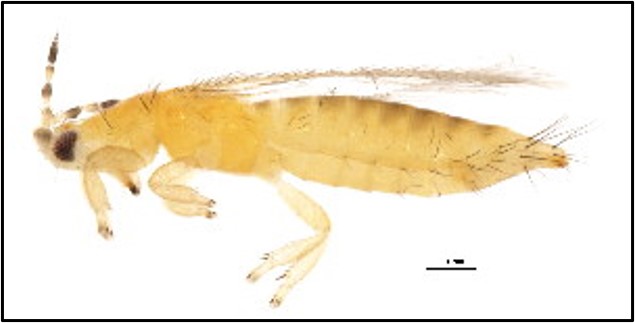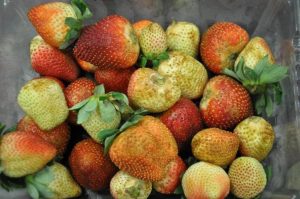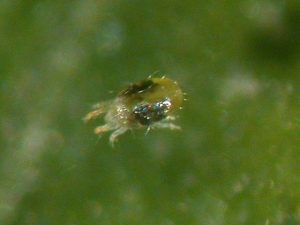Managing Thrips, Tarnished Plant Bugs, and Mites in Strawberry Fields
As the strawberry growing season progresses, it is essential for berry growers to remain vigilant against pests such as thrips, tarnished plant bugs (TPB), and two-spotted spider mites (TSSM). These pests can cause significant damage to strawberry crops, impacting both yield and fruit quality. The recommendations provided here discuss monitoring and management strategies to help growers protect their crop.
Thrips Management


Thrips, particularly the Eastern flower thrips (Frankliniella tritici; Figure 1), often arrive in strawberry fields via southern wind currents. They can be challenging to detect but monitoring is essential. Growers should:
- Scout early and regularly: Thrips tend to move into plantings on early spring windstorms such as we’ve been having lately. Start scouting at the beginning of the season and continue weekly. I have heard reports from a grower that they detected thrips in their strawberry planting last week.
- Use effective monitoring techniques: Shake or tap 10 blossoms per site at 10 or more sites per variety over a white bowl or tray. Alternatively, place flower blossoms inside a Ziploc bag and shake to dislodge thrips for counting. Sticky cards can also be used but no threshold is established for them. As thrips can often be overlooked with these methods, I highly recommend strawberry growers look directly at 10 plants per site at 5 to 10 different areas depending on the size of the fields at least once a week and particularly following southernly wind patterns to assess for the presence of thrips. I recommend implementing chemical control if more than 5 thrips per flower are found. As fruit develops, scouting for damage symptoms directly on fruit as soon as fruit is present is very important to ensure proper management strategies can be implemented swiftly. For pictures of bronzing or discoloration symptoms and small hard and seedy berries, please refer to this Ohio State University article or see Figure 1 as an example. 50 fruit in each area should be examined or removed and placed individually in Ziploc bags. Bags can be placed in the sun so that the heat makes the thrips move around and easier to count. When fruit has reached ¼ inch in diameter, the action threshold of 0.5 thrips per fruit can be used to trigger a chemical control. Scouting should continue until fruit has reached ~1/2 inch diameter.
- Chemical Control: If monitoring indicates the presence of thrips at or above threshold levels, consider the following insecticides:
- Pyrethroids: Brigade, Danitol
- Spinosyns: Entrust, Radiant, Delegate
- Neonicotinoids: Assail
- For organic production, Entrust, Aza-Direct, Grandevo, and Pyganic are effective options.
Tarnished Plant Bug (TPB) Management

TPBs (Lygus lineolaris; Figure 3) start moving into strawberry fields as soon as plants bloom. Both adults and nymphs feed on strawberry plants and can cause damage.
- Scouting: Use sweep nets weekly to monitor for adults and nymphs.
- Action thresholds: Implement chemical control if you find 4 adults per 20 sweeps or 1 nymph in 4 flower clusters.
- Chemical Control: Effective insecticides for TPB include:
- Pyrethroids: Brigade, Danitol
- Neonicotinoids: Actara, Assail
- For organic production, products containing Azadirachtin are recommended.
Two-Spotted Spider Mites (TSSM) Management

TSSMs (Tetranychus urticae; Figure 4) can become problematic, especially under dry conditions and with excessive nitrogen fertilization.
- Biological control: Predatory mites can keep TSSM populations in check. A ratio of one predatory mite to 10 TSSM is effective.
- Avoid mite flare-ups: Pyrethroid insecticides can cause mite flare-ups by reducing natural enemy populations.
- Chemical Control: If infestations reach 25% of leaflets sampled (1 or more mites on 15 out of 60 leaflets), use the following miticides:
- Conventional options: Abamectin (Agri-Mek), etoxazole (Zeal), hexythiazox (Savey), bifenazate (Acramite), acequinocyl (Kanemite), fenpyroximate (Portal), and Assail.
- Organic options include mineral oils and sesame oil.
General Recommendations
Regular monitoring and scouting. Set up monitoring traps and start sampling protocols early in the season.
Threshold-based management. Implement chemical controls based on established action thresholds to minimize unnecessary pesticide use and protect natural enemies and pollinators.
Pollinator protection: Always consider pollinator safety when planning pesticide applications. Avoid spraying during bloom. If spraying is necessary, do so before blossoms open or before 10% of plants have open blossoms. If you plan to use chemical control, consider using reduced-risk insecticides and apply pesticides at night to reduce direct exposure to pollinators. For more information on how to select pesticides, please see this Oregon State publication or download the app “Reduce bee poisoning from pesticides”.
For more information on chemical control in strawberries, refer to the 2023-2024 Midwest Fruit Pest Management Guide and other resources provided by university extension services.
Happy growing season!
This article was posted in Berries, Insects and tagged Christelle Guédot, insects, Mites, Strawberries, Tarnished Plant Bug, Thrips, two-spotted spider mites.
